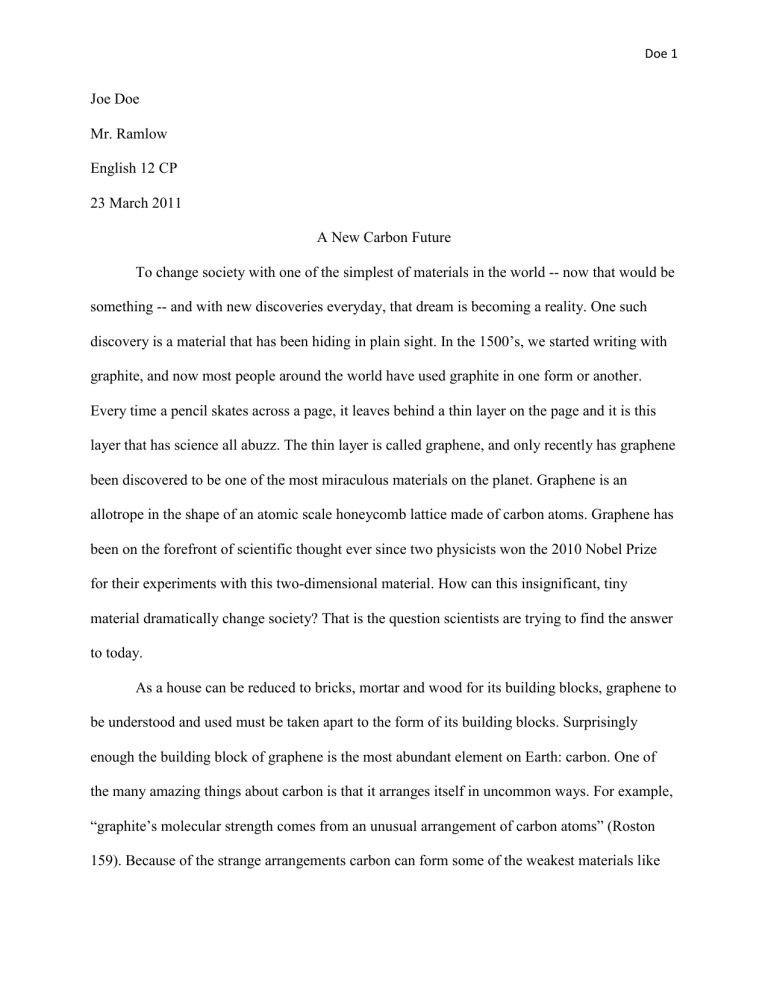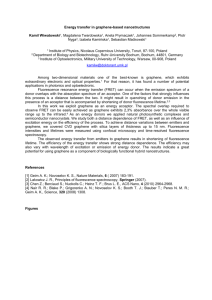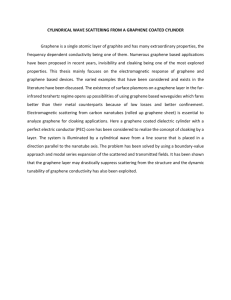Doe Joe Doe Mr. Ramlow English 12 CP 23 March 2011 A New

Doe 1
Joe Doe
Mr. Ramlow
English 12 CP
23 March 2011
A New Carbon Future
To change society with one of the simplest of materials in the world -- now that would be something -- and with new discoveries everyday, that dream is becoming a reality. One such discovery is a material that has been hiding in plain sight. In the 1500’s, we started writing with graphite, and now most people around the world have used graphite in one form or another.
Every time a pencil skates across a page, it leaves behind a thin layer on the page and it is this layer that has science all abuzz. The thin layer is called graphene, and only recently has graphene been discovered to be one of the most miraculous materials on the planet. Graphene is an allotrope in the shape of an atomic scale honeycomb lattice made of carbon atoms. Graphene has been on the forefront of scientific thought ever since two physicists won the 2010 Nobel Prize for their experiments with this two-dimensional material. How can this insignificant, tiny material dramatically change society? That is the question scientists are trying to find the answer to today.
As a house can be reduced to bricks, mortar and wood for its building blocks, graphene to be understood and used must be taken apart to the form of its building blocks. Surprisingly enough the building block of graphene is the most abundant element on Earth: carbon. One of the many amazing things about carbon is that it arranges itself in uncommon ways. For example,
“graphite’s molecular strength comes from an unusual arrangement of carbon atoms” (Roston
159). Because of the strange arrangements carbon can form some of the weakest materials like
Doe 2 soot while also being able to form the strongest of materials like diamonds. Carbon is one of the most significant elements needed for life: “Carbon is the ubiquitous architect, builder, and most basic building material of life. It’s the molecular scaffold of every living creature and all the dead ones, too” (Roston 2). Carbon also forms one of the most unique materials in the world this material is the only known material to be stable at the width of one atom thick. This amazing material is of course graphene.
Not only does the building block of graphene have an exciting story but so does its history. Graphene’s story begins with not its discovery but the discovery of another important material. In England 1564 a huge graphite mine was discovered and early forms of pencils began to develop. The pencil freed writers from having to carry quill and inkwell; however no one could comprehend that this simple device might one day revolutionize some future society. Soon scientists eventually began to theorize the possibility of a material one atom thick being pulled from graphite. The idea was not well defended as “In 1947, there was widespread skepticism when scientists theorized that graphene could be produced, and the disbelief continued into the
1960s” (Jones). Then in 2010 the “Nobel Prize for Physics was awarded to Andre K. Geim and
Konstantin S. Novoselov … for succeeding in producing, isolating, identifying and characterizing … graphene” (“Graphene”). You have got to be someone special to make such a revolutionary development in science.
In 2004 two physicists, both researchers at the university at the University of Manchester,
U.K., Andre K Geim and Konstantin S. Novoselov began writing articles about graphene and its potential. Through the next several years they tried to create a one atom thick layer of graphene from graphite “By applying Scotch tape to graphite, they could pull off thin flakes that consist of one… or many layers of graphene” (Day). Surprisingly enough the use of tape was an accident,
Doe 3 they were actually throwing the tape away and evaluating the substance left behind by the tape.
One day they decided to look at the tape more closely, what they discovered was each time they folded the tape in on itself the graphene layer got thinner until they created a one atom thick layer. This was such an amazing discovery that these two scientists were awarded the 2010
Nobel Prize in physics. Interesting fact about Geim he also won the Ig Nobel Prize (a prize that honors humorous achievements that also make people think) for his studies on magnetism where he levitated a frog. He also made his hamster H.A.M.S. ter Tisha the coauthor of one of his research papers. Both Geim and Novoselov are Knight Commanders in the Order of the
Netherlands Lion (the country’s most prestigious award). The awards and recognition all come back to the research done on graphene.
Not everything has been rolling smoothly for graphene there are some bumps on its road to revolutionary development. One problem is that there is still no efficient way to quickly separate graphene from graphite. There are many scientists at universities, research centers and major tech companies around the world working on these problems. Another major problem is to be able to produce graphene on an industrial scale. According to many scientists we must be able to create in atmosphere, not in a vacuum. According to Pennsylvania University physics professor Charlie Johnson, “If you need to work in a high vacuum, you need to worry about getting it into and out of a vacuum chamber without having a leak, if you’re working at atmospheric pressure, you can imagine electropolishing the copper, depositing the graphene onto it and then moving it on to a conveyor belt to another process in the factory” (Lerner). The advantage of separating graphene layers in atmospheric pressure is that it is much more cost effective for factories to produce the graphene layers. There are attempts to use graphene as a
semiconductor to improve computers but it “has a flaw, electrical leakage.” (Montgomery).
Doe 4
Another problem is that it is so small it is hard to work with, but this can be a benefit as well.
As far as technology is concerned the smaller the better. Even large pieces of technology run fast because the parts inside them are small, so more can happen in the inner workings.
Currently “The unique properties of graphene have already led researchers to look at ways the material could be used in the development of increasingly small and fast transistors” (“New”) and as this happens technology improves. One of the most promising characteristics of graphene is that it is so small. There is a law called Moore’s Law, this 40-year-old law basically states that technology doubles every two years. We are fast approaching the end of Moore’s Law. Silicon, the stuff of transistors and chips, is at its limit of shrinkage; it just doesn’t function at an atomic level. Graphene on the other hand, as we have learned, functions at the single atom level. As technology continues to shrink with the use of graphene the possibilities in nanotechnology increase, in fact mini submarines inside your body curing diseases might not be that far off.
Not only is graphene shrinking technology, but it might be improving electricity flow in general. The idea has been tossed around to use graphene as a superconductor. A superconductor is a material that gives zero resistance to electrical particles as electricity flows through it. Due to its two-dimensional shape graphene already gives very little resistance to the flow of electricity.
According to Walt se Heer, physics professor at Georgia Tech, one goal of graphene is to try to have electricity flow through the “diffraction of electrons rather than diffusion of electrons. This will allow production of very small devices with very high efficiency and low power consumption.” (“Georgia”) The diffraction of electrons will make electrons act more like waves than particles, which will improve overall efficiency in technology. Graphene is so useful for so
Doe 5 many parts of technology it’s amazing that such a simple material can change both electrical flow and general technology.
The graphene sheet shape isn’t graphene’s only shape it can be rolled up into tubes called nanotubes. Not only can it be rolled up but depending on the direction it is rolled it has different properties. Graphene can be rolled three different ways, “in ‘zigzag’ tubes…some of the C-C bonds lie parallel to the tube axis… [in] ‘armchair’ tubes… some bonds are perpendicular to the axis… Chiral tubes have a left- or right-handed screw axis, like DNA.”(“What”) Nanotubes are also very powerful and can be used to improve many materials of today’s society. The nanotube is amazing, in fact “A single perfect nanotube is about 10 to 100 times stronger than steel per unit weight” ( C r e s p i ). The power of a simple nanotube could just replace the entire industry of steel.
With all of the amazing abilities of graphene, what are the things that it can actually create? A weird idea made possible due to graphene is a bendable battery, why this would be useful has not been answered but it is kind of cool. Another battery idea is using graphene to make a supercapacitor. To imagine what a supercapacitor is imagine a normal rechargeable battery that takes about three hours to charge now imagine the same amount of charge in a couple seconds. As discussed earlier it can be used to make material that is stronger than steel. It also repels and disperses water and it is transparent so it can be used as a coat to protect windshields and eliminate the need for windshield wipers.
As the development on graphene continues the results will improve the life of all of
Earths inhabitants. From the beginnings of an element known as carbon to the discovery of the small one atom thick material graphene our world will change one atom at a time. There are some problems with graphene but the potential in nanotechnology and electricity is great.
Doe 6
Beyond that graphene is very diverse as it can be rolled up many ways and be used in many new inventions along the way. With all the potential that graphene holds, the world will have to wait for its next exciting move.
Doe 7
W o r k s C i t e d
D a y , C h a r l e s . " A n d r e G e i m a n d K o n s t a n t i n N o v o s e l o v w i n 2 0 1 0 p h y s i c s
N o b e l P r i z e f o r g r a p h e n e . " P h y s i c s T o d a y
2 0 F e b 2 0 1 1 . < p h y s i c s t o d a y . o r g > .
. N . p . , 0 5 O c t 2 0 1 0 . W e b .
C r e s p i , V . H . " C a r b o n N a n o s t r u c t u r e s . " P e n n S t a t e . N . p . , 2 0 1 0 . W e b . 1 5 M a r
2 0 1 1 . < p h ys . p s u . e d u > .
" G e o r g i a T e c h r e s e a r c h e r s d e v e l o p n e w a p p r o a c h t o c a r b o n - b a s e d e l e c t r o n i c s . " S c h o o l o f P h y s i c s
< g e o r g i a t e c h . e d u > .
1 4 M a r 2 0 0 6 : 4 . W e b . 1 6 M a r 2 0 1 1 .
" G r a p h e n e : a n o v e l m a t e r i a l w i t h m y r i a d u s e s . " T h e H i n d u . N . p . , 0 7 O c t
2 0 1 0 . W e b . 2 0 F e b 2 0 1 1 . < h i n d u . c o m > .
J o n e s , K . C . " A t o m - T h i n M a t e r i a l C o u l d R e p l a c e S i l i c o n F o r
C h i p s . " I n f o r m a t i o n W e e k
< i n f o r m a t i o n w e e k . c o m > .
0 5 M a y 2 0 0 9 : 2 . W e b . 1 0 M a r 2 0 1 1 .
L e r n e r , E v a n . " P e n n P h y s i c i s t s D e v e l o p S c a l a b l e M e t h o d f o r M a k i n g
G r a p h e n e . " P e n n S t a t e . N . p . , 2 4 F e b 2 0 1 1 . W e b . 1 6 M a r 2 0 1 1 .
< u p e n n . e d u > .
M o n t g o m e r y , M i c h a e l . " M o l y b d e n u m M a y R e v o l u t i o n i z e
N a n o t e c h n o l o g y . " M o l y I n v e s t i n g N e w s . N . p . , 0 3 F e b 2 0 1 1 . W e b .
1 0 M a r 2 0 1 1 . < m o l y i n v e s t i n g n e w s . c o m > .
Doe 8
" N e w M a t e r i a l D e r i v e d F r o m G r a p h e n e M a y H a v e M a n y A p p l i c a t i o n s I n
F u t u r e E l e c t r o n i c s . " S c i e n c e D a i l y . N . p . , 0 9 F e b 2 0 0 9 . W e b . 3 M a r
2 0 1 1 . < s c i e n c e d a i l y . c o m > .
R o s t o n , E r i c . T h e C a r b o n A g e . 1 s t . N e w Y o r k , N Y : W a l k e r & C o m p a n y ,
2 0 0 8 . 3 1 1 . P r i n t .
" W h a t i s a C a r b o n N a n o t u b e . " P e n n E n g i n e e r i n g . N . p . , J u l 2 0 0 5 . W e b .
1 0 M a r 2 0 1 1 . < s e a s . u p e n n . e d u > .




